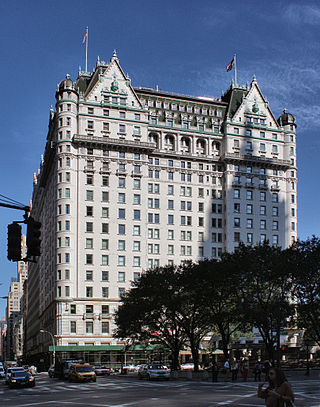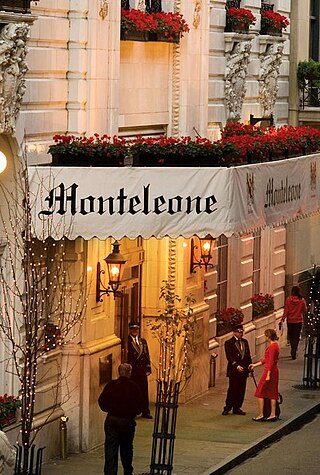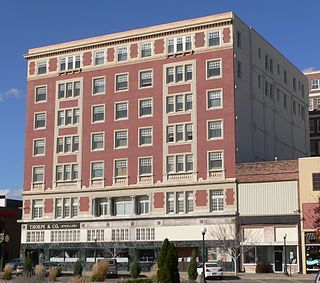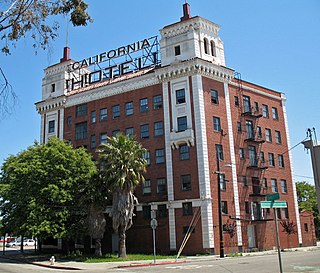
The Waldorf Astoria New York is a luxury hotel and condominium residence in the Midtown Manhattan neighborhood of New York City, United States. The structure, at 301 Park Avenue between 49th and 50th Streets, is a 47-story, 625 ft (191 m) Art Deco landmark designed by architects Schultze and Weaver and completed in 1931. The building was the world's tallest hotel until 1957, when it was surpassed by Moscow's Hotel Ukraina. An icon of glamor and luxury, the Waldorf Astoria is one of the world's most prestigious and best-known hotels. Once owned by Conrad Hilton, Waldorf Astoria Hotels & Resorts, a division of Hilton Hotels, operates under the name of the original hotel in locations around the world. Both the exterior and the interior of the Waldorf Astoria are designated by the New York City Landmarks Preservation Commission as official landmarks.

The Plaza Hotel is a luxury hotel and condominium apartment building in Midtown Manhattan in New York City. It is located on the western side of Grand Army Plaza, after which it is named, just west of Fifth Avenue, and is between 58th Street and Central Park South, at the southeastern corner of Central Park. Its primary address is 768 Fifth Avenue, though the residential entrance is One Central Park South. Since 2018, the hotel has been owned by the Qatari firm Katara Hospitality.

The Mayflower Hotel is a historic hotel in downtown Washington, D.C., located on Connecticut Avenue NW. It is two blocks north of Farragut Square and one block north of the Farragut North Metro station. The hotel is managed by Autograph Collection Hotels, a division of Marriott International.

The Roosevelt New Orleans in New Orleans, Louisiana, is a 504-room hotel owned by AVR Realty Company and Dimension Development and managed by Waldorf Astoria Hotels & Resorts. The hotel was originally built by Louis Grunewald, a German immigrant, and opened in 1893 as "The Hotel Grunewald."

The Hotel Flor Tampa Downtown, Tapestry Collection by Hilton, formerly known as the Hotel Floridan or Floridan Palace Hotel, is a historic hotel in Tampa, Florida, United States. It is located at 905 North Florida Avenue in the north end of the downtown core. It was designed by prominent Tampa architects G.A. Miller and Francis J. Kennard and built in 1926, opening in early 1927. On March 12, 1996, the Floridan was added to the U.S. National Register of Historic Places. The hotel is known to be one of the most haunted buildings in Downtown Tampa, with the highest levels of activity taking place in the lobby as well as various guestrooms.

The Hotel Pennsylvania was a hotel at 401 Seventh Avenue in Midtown Manhattan, New York City, across from Pennsylvania Station and Madison Square Garden. Opened in 1919, it was once the largest hotel in the world. It remained the city's fourth-largest until it closed permanently on April 1, 2020. After years of unsuccessful preservation battles, it was demolished in 2023. The hotel is to be replaced by 15 Penn Plaza, a 68-story tower.

InterContinental Chicago Magnificent Mile is a hotel in Chicago, United States. The hotel currently occupies two multi-story buildings. The historic tower, or "South Tower," is a 471-foot (144 m), 42-story building which was completed in 1929 originally as the home of the Medinah Athletic Club. The new tower, or "North Tower" is a 295-foot (90 m), 26-story addition, completed in 1961.

The Langham, Boston is a luxury hotel in a historic building located at 250 Franklin Street in the financial district of Boston, Massachusetts. It is a member of The Leading Hotels of the World and managed by Langham Hotels International.

The University Club is an eight-story building of the University of Pittsburgh designed by Henry Hornbostel and completed in 1923 that is a contributing property to the Schenley Farms Historic District on the school's campus in Pittsburgh, Pennsylvania, United States. It serves as a faculty club with publicly accessible dining, banquet, and conference facilities, while the upper four floors serve as undergraduate student housing referred to as University Hall.

The Down Town Association in the City of New York, usually referred to as the Down Town Association or the DTA, for short, is a private club in the Financial District of Manhattan, New York City.
The Eppley Hotel Company was located in Omaha, Nebraska. At the time of its acquisition by the Sheraton Corporation in 1956, it had 22 properties, and it was the largest privately held hotel business in the United States.

The Hotel Tallcorn is located in Marshalltown, Iowa. Today it is called the Tallcorn Towers Apartments. Built in 1928 by the Eppley Hotel Company, local citizens contributed $120,000 to ensure the successful completion of this seven-story hotel. It was completed in connection to the seventy-fifth anniversary of Marshalltown. The hotel's sale in 1956 from the Eppley chain to the Sheraton Corporation was part of the second largest hotel sale in United States history. The Tallcorn was listed as a contributing property in the Marshalltown Downtown Historic District on the National Register of Historic Places in 2002.

Thomas Jefferson Tower, originally the Thomas Jefferson Hotel and then the Cabana Hotel, is a 19-story building on the western side of downtown Birmingham, Alabama. It was completed in 1929 as the 350-room Thomas Jefferson Hotel and is at 1623 2nd Avenue North. It has a tower in its roof intended to be a zeppelin mooring mast.

Hotel Monteleone is a family-owned and operated hotel located at 214 Royal Street in the French Quarter of New Orleans, Louisiana, U.S. The hotel includes the only high-rise building in the interior French Quarter and is well known for its Carousel Piano Bar & Lounge, a rotating bar.

The Martin Hotel, erected as a Chicago style building in 1912, is located in Sioux City, Iowa. Added to the National Register of Historic Places in 1983, it is significant for its architecture, operating for many years as the Sheraton-Martin Hotel and now known as the Martin Tower Apartments.

The Hotel Blackhawk is an eleven-story brick and terra cotta building located in Downtown Davenport, Iowa, United States. It is a Marriott Autograph Collection property.

The La Salle Hotel was a historic hotel located on the northwest corner of La Salle Street and Madison Street in the Chicago Loop community area of Chicago, Illinois, United States. It was designed by Holabird & Roche and opened in 1909. After a major fire in 1946, the hotel was refurbished and reopened in 1947. It closed in 1976 and was demolished for construction of an office building.

The Hotel Alexandria is a historic building constructed as a luxury hotel at the beginning of the 20th century in what was then the heart of downtown Los Angeles. As the business center of the city moved gradually westward, the hotel decayed and gradually devolved into a single-room occupancy (SRO) hotel housing long-term, low income residents and gained a reputation for crime and being unsafe. Revitalization of the area in the 21st century changed the rental practices and neighborhood safety.

The California Hotel is a historic Oakland, California, hotel which opened in the early days of the Great Depression and became an important cultural center for the African-American community of San Francisco's East Bay during the 1940s, 50s and 60s. On June 30, 1988, the hotel was placed on the National Register of Historic Places.

Conrad Bangkok is a hotel in Bangkok, Thailand, that is part of the Conrad Hotels brand owned by Hilton Worldwide. It opened in 2003. The hotel has 392 rooms and suites. There are six restaurants and lounges at the hotel including KiSara restaurant which serves Japanese cuisine and Liu restaurant which offers traditional Chinese food. The hotel also has a gym, a spa, a swimming pool, tennis courts, and a rooftop jogging track.






















